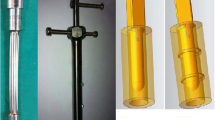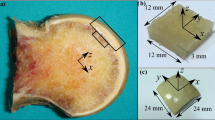Abstract
This study investigated the relationship of bone porosity and bone–cement interface shear strength. One hundred forty-six samples were taken from the distal metaphysis of 20 bovine femora. After cementation, the shear strength of the bone–cement interface was tested. According to the porosity, the samples were divided into four groups. Group I (porosity <80%) had a median interface shear strength of 4.03 MPa, group II (80% ≤porosity <85%) 7.06 MPa, group III (85% ≤porosity <90%) 9.44 MPa, and group IV (porosity ≥90%) 14.85 MPa. The differences between the four groups were statistically significant. Greater porosity yielded a stronger bone–cement interface shear strength under the identical cementation technique. The optimum porosity of cancellous bone is more than 90% which can be found by reaming or drilling to deeper bone in cemented acetabular fixation.
Résumé
L’objet de cette étude est d’apprécier les relations entre la porosité osseuse et l’interface ciment-os. 146 échantillons osseux prélevés sur la métaphyse distale de 20 fémurs bovins ont permis de tester l’interface ciment-os après cimentation. suivant leur degré de porosité, les échantillons ont été divisés en 4 groupes. Groupe I porosité < 80% avec des forces, au niveau de l’interface de 4,03 MPa, groupe II porosité comprise entre 80 et 85% (7,06 MPa), groupe III porosité comprise entre 85 et 90% (9,44 MPa) et groupe IV porosité inférieure à 90% (14,85 MPa). Les différences entre ces 4 groupes sont statistiquement significatives. une plus grande porosité permet l’application de forces plus importantes au niveau de l’interface ciment-os après cimentation. La porosité optimum au niveau de l’os spongieux doit être supérieur à 90% et cette porosité peut être augmentée par l’alésage et les trous d’ancrages au niveau de la zone de fixation acétabulaire.

Similar content being viewed by others
References
Andersson GB, Freeman MA, Swanson SA (1972) Loosening of the cemented acetabular cup in total hip replacement. J Bone Joint Surg [Br] 54-B:590–599
Askew MJ, Steege JW, Lewis JL, Ranieri JR, Wixson RL (1984) Effect of cement pressure and bone strength on polymethylmethacrylate fixation. J Orthop Res 1:412–420
Balu GR, Nobel PC, Alexander JW, Vela VL (1994) The effect of intramedullary reaming on the strength of the cement/bone interface. Trans Orthop Res Soc 19:797
Bannister GC, Miles AW (1988) The influence of cementing technique and blood on the strength of the bone-cement interface. Eng Med 17:131–133
Bean DJ, Convery FR, Woo SL, Lieber RL (1987) Regional variation in shear strength of the bone-polymethylmethacrylate interface. J Arthroplasty 2:293–298
Bland JM, Altman DG (1999) Measuring agreement in method comparison studies. Stat Methods Med Res 8:135–160
Bugbee WB, Barrera DL, Lee AC, Convey FR (1992) Variations in shear strength of the bone cement interface in the proximal femur. Trans Orthop Res Soc 17:22
Cornell CN, Ranawat CS (1986) The impact of modern cement techniques on acetabular fixation in cemented total hip replacement. J Arthroplasty 1:197–202
Dohmae Y, Bechtold JE, Sherman RE, Puno RM, Gustilo RB (1988) Reduction in cement-bone interface shear strength between primary and revision arthroplasty. Clin Orthop Relat Res 236:214–220
Halawa M, Lee AJ, Ling RS, Vangala SS (1978) The shear strength of trabecular bone from the femur, and some factors affecting the shear strength of the cement-bone interface. Arch Orthop Trauma Surg 92:19–30
Hodgkinson JP, Maskell AP, Paul A, Wroblewski BM (1993) Flanged acetabular components in cemented Charnley hip arthroplasty. Ten-year follow-up of 350 patients. J Bone Joint Surg [Br] 75-B:464–467
Kobayashi S, Terayama K (1990) Radiology of low-friction arthroplasty of the hip. A comparison of socket fixation techniques. J Bone Joint Surg [Br] 72-B:439–443
Kobayashi S, Terayama K (1993) Factors influencing survival of the socket after primary low-friction arthroplasty of the hip. Arch Orthop Trauma Surg 112:56–60
Köbel R, Bergmann G, Boenick U (1976) Mechanical engineering of the cement bone bond. In: Schldach M, Hohman D (eds) Engineering in medicine. Springer, New York, pp 347–357
Krause WR, Krug W, Miller J (1982) Strength of the cement-bone interface. Clin Orthop Relat Res 163:290–299
Majkowski RS, Miles AW, Bannister GC, Perkins J, Taylor GJ (1993) Bone surface preparation in cemented joint replacement. J Bone Joint Surg [Br] 75-B:459–463
Reading AD, Miles AW, Bannister GC (2002) Keyholes in acetabular preparation. Hip International 12:163–165
Volz RG, Wilson RJ (1977) Factors affecting the mechanical stability of the cemented acetabular component in total hip replacement. J Bone Joint Surg [Am] 59-A:501–504
Author information
Authors and Affiliations
Corresponding author
Rights and permissions
About this article
Cite this article
Amirfeyz, R., Bannister, G. The effect of bone porosity on the shear strength of the bone–cement interface. International Orthopaedics (SICOT) 33, 843–846 (2009). https://doi.org/10.1007/s00264-008-0558-3
Received:
Accepted:
Published:
Issue Date:
DOI: https://doi.org/10.1007/s00264-008-0558-3




